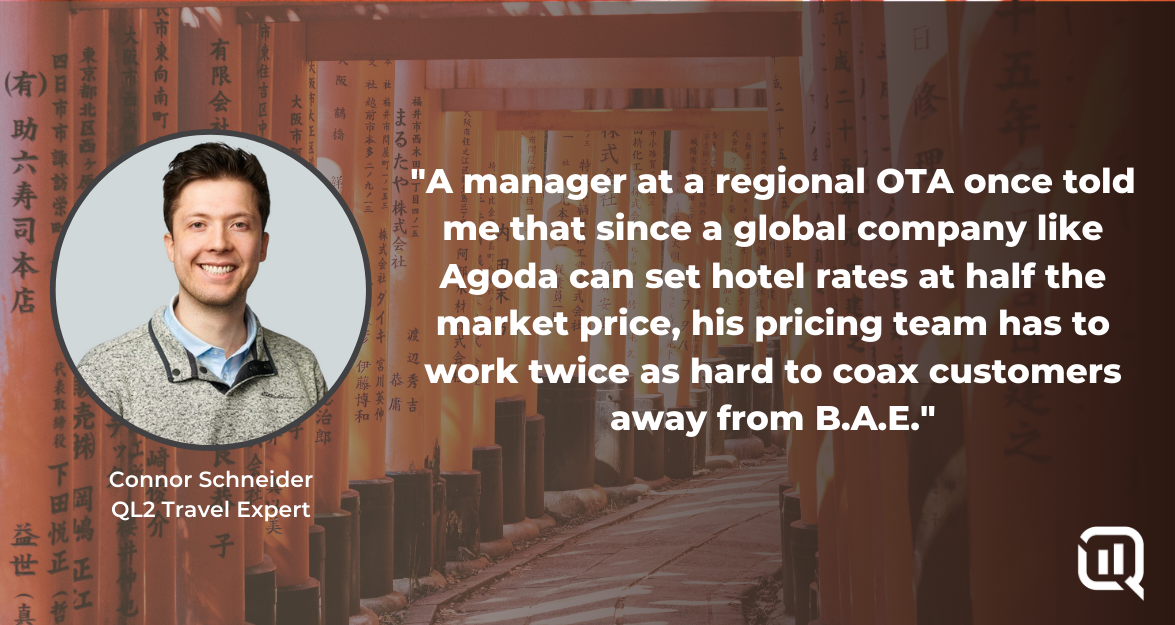Today, planning a vacation is as easy as opening Google. Trips requiring the labor of a local travel agent are decades in the past. Instead, countless online travel booking websites jockey to facilitate the planning of a trip. Whether it be a flight, stay in a hotel, rental car or an entire vacation package, each agency will offer slightly different rates to secure the booking.
The globally dominant online travel agencies; Booking, Agoda and Expedia (B.A.E) boast an impressive share of the OTA market. To maintain their positions, they spend money equivalent to the GDP of some small countries to appear on the top of a Google results page on any given itinerary search. Smaller online agency websites and direct hotel websites are interspersed with the results. Over the years I’ve done more work with smaller OTA groups than the multibillion dollar industry leaders, and I’ve always been curious about how the smaller players remain competitive so that they aren’t priced out of the market. Using a personal story of a recently planned trip, I will highlight the entrenched reach of the major OTAs and what regional online agencies need to focus on to stay competitive.
Some friends and I have been gradually booking hotels in each city of our upcoming tour of Japan, and we used a different online travel agency to book each hotel. In Tokyo, the cheapest rate by far for the hotel we picked was advertised on Agoda. Our single night near Mt. Fuji was booked through Expedia, while our stays in Kyoto and Osaka were secured using Booking.com and Priceline. Using different agency websites for each hotel certainly makes trip planning a bit messier, but the travel savings were worth having to manage login information for each. I didn’t only rely on the top sponsored Google result to determine which agency to book through. In my attempt to be a savvy consumer, I made use of comparison tools like Google Travel and TripAdvisor to get a clearer picture of which OTA would reduce their margins low enough for me to click ‘book’. To ensure I was doing my due diligence and not cutting corners in my research, I also looked at the direct listing site for each hotel we picked. But having rates advertised in yen that converted into a nightly room rate that was always higher than what was advertised on an OTA meant I didn’t stay on those websites for very long!
It’s not news to smaller OTAs that it’s next to impossible to directly compete with B.A.E. They have margin flexibility that would put most other competitors out on the street if they tried to match it. I saw several examples where the Booking rate was cheaper than the rate on the actual hotel website. That suggests that Booking was sacrificing part of the commissions they earned from the hotel to undercut their competitors. So if a local agency hasn’t a chance to compete on price, where are their opportunities?
Focusing on the Local Market
While B.A.E have the benefit of being global booking hubs, that means that they don’t know regional travel markets nearly as well. Smaller agencies that are well known and respected in their country have a huge advantage there. I’ve worked with companies that advertise themselves as the preferred agency of Canada, or of Brazil, and find success reaching travelers in their country. Travelers are apprehensive about booking trips through OTAs that they aren’t familiar with, so focusing marketing in local areas evens the name-recognition playing field.
Building a Network of Hotel Partners
While the hotel booking is not the only piece of a travel itinerary, it is the most important for OTAs. It’s in the hotel price that agencies have the most flexibility to capture a sale, while the prices of flights are mostly locked in by the carriers. Building out a network of hotels in key destinations that can advertise certain online agencies as key partners for booking is the first step. Working with those hotels to set pricing floors and ceilings that enable flash sales to move excess inventory or temporarily match major OTA price reductions open up revenue opportunities. A manager at a regional OTA once told me that since a global company like Agoda can set hotel rates at half the market price, his pricing team has to work twice as hard to coax customers away from B.A.E.
Have a Clear Picture of Competitive Position in the Market
It is vital for a smaller OTA to have a clear, reportable view of where they stand in the market compared to their local and international competitors. The fog of war that has a tendency to hover over competitive comparisons has a much more damaging effect on regional OTAs than it does for their counterparts. It’s not enough to know that B.A.E is beating them on price generally. Information around which markets, hotels and days when competitiveness is not being maintained is necessary to have a fighting chance at reclaiming some price parity.
The travel management industry has irreversibly changed over the last several decades. Once protected by the opaque systems of GDS platforms, smaller travel agencies were gradually exposed to direct competition from online aggregators. Unable to pivot quickly enough to the new online paradigm, many agencies crumbled into dust under the pressure. In today’s travel world, where OTAs like B.A.E. reign supreme, the remaining local agencies need to invest in every practice and tool that can give them an edge over their market-making competitors. Local customer advertising, close communication and partnership with their top hotel providers and maintaining a crystal clear picture of their competitive positions are table stakes for OTAs that hope to see next year.

Helping product/merchandising teams identify pricing gaps to maximize sales and profitability.


